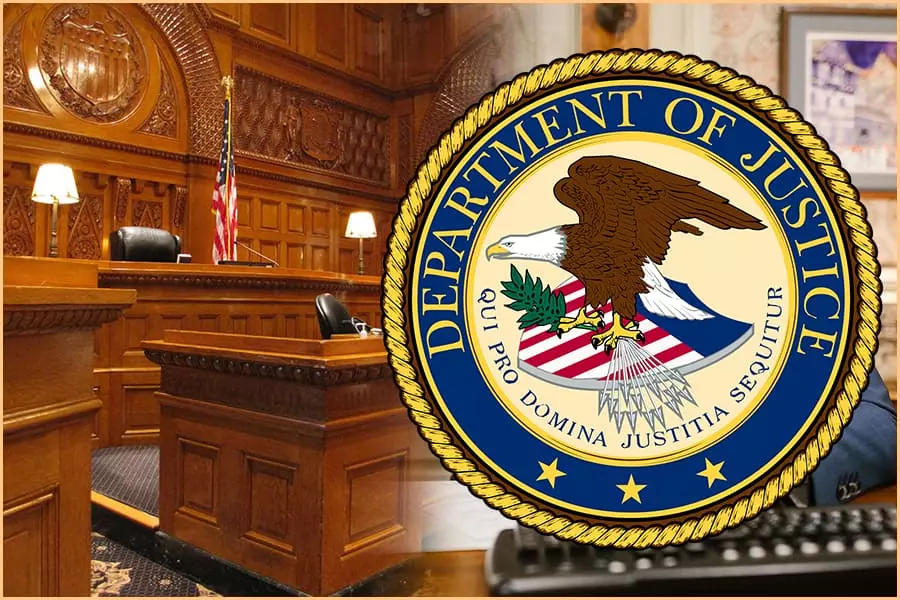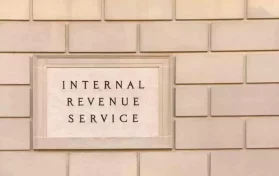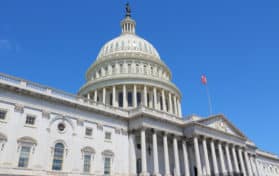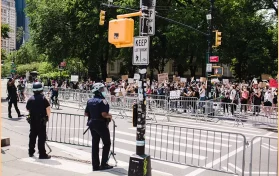
The United States Department of Justice, sometimes referred to as the Justice Department, is a part of the federal executive department of the American government. Its chief duty is to enforce federal law in the United States and to administer justice as well. The Justice Department is headed by the United States Attorney General, who is a member of the president’s cabinet.
The United States Attorney General, currently Merrick Garland, was nominated by the president and the position must be confirmed by Congress. Garland was sworn into the position on March 11, 2021.
The Department of Justice was established on July 1, 1870. The Justice Department is housed at the Robert F. Kennedy Department of Justice Building in Washington, D.C., just a few blocks away from the White House.
The motto of the Justice Department is “Qui Pro Domina Justitia Sequitur,” which means Who prosecutes on behalf of the Lady Justice.
The Department of Justice employs approximately 113,114 individuals, and the annual budget for the Justice Department is approximately $30 billion. At present, other than Merrick Garland, the top employees at the Department of Justice include Deputy Attorney General Lisa Monaco; Vanita Gupta, Associate Attorney General; and Elizabeth Prelogar, Solicitor General.
The Department of Justice was established in 1870 during the presidency of Ulysses S. Grant. The Justice Department is made up of multiple law enforcement agencies, including the following:
- the Bureau of Alcohol, Tobacco, Firearms, and Explosives
- the Federal Bureau of Prisons
- the U.S. Marshals Service
- the Drug Enforcement Administration
- the Federal Bureau of Investigation
There are three chief purposes for the Justice Department. First, the Justice Department represents the United States government in legal matters (such as cases that are presented in the U.S. Supreme Court), investigating and prosecuting white collar crime, and operating the federal prison system. The Department of Justice is also tasked with overseeing and reviewing the conduct of local law enforcement; this task is set forth by the Violent Crime Control and Law Enforcement Act of 1994.
The History of the Department of Justice
The Judiciary Act of 1789 established the office of the United States Attorney General, which was originally a part-time position only. Eventually, the office of the Attorney General became a bureaucracy. Initially, the Attorney General was tasked with providing legal advice to Congress and the President as necessary. However, by 1819, this became a role in which the Attorney General provided legal advice solely to Congress. This was so the Attorney General could work under a manageable load.
Because the office of the Attorney General was once a part-time position, many of those in the position were allowed work in the private sector so that they could manage living expenses while carrying out the government position. In 1830 and and 1846, Congress attempted to make the position of United States Attorney General a full-time position. However, their initial efforts were unsuccessful. In 1867, however, Congress’ United States House Committee on the Judiciary conducted an investigation into creating a law department headed by the U.S. Attorney General. Congressman William Lawrence headed the effort. The department in question would be filled by multiple department solicitors as well as multiple United States attorneys. By February 1868, the group had drafted a bill which maneuvered its way through Congress. President Grant signed the bill into law on June 22, 1870.
The initial United States Attorney General was Amos T. Akerman. Benjamin H. Bristow was the first solicitor general. Grant made these appointments during the first week that the Department of Justice was established.
The initial activities of the Department of Justice were to protect and preserve civil rights. This was during the time that the thirteenth, fourteenth, and fifteenth amendments had been introduced and added to the Constitution. Many groups were working at that time to create domestic terrorist groups that, at the time, were utilizing both violence and litigation to fight against these amendments.
In the 1870s, Akerman and Bristow were tasked with prosecuting members of the Ku Klux Klan, a group responsible for some of the violent protests against those previously mentioned amendments. During this time, there were more than one thousand indictments against members of the KKK; the pair garnered more than 550 convictions. In 1871, there were 3,000 indictments with 600 convictions; however, most only served brief sentences while those who organized the disturbances received at least five years in a federal prison in New York. As a result, violence in the South decrease dramatically.
The Department of Justice during the terms when Grant was president spent most of its time prosecuting Klan activity. By the mid-1870s, the second U.S. Attorney General – George Williams, placed a moratorium on Klan prosecutions as the DOJ did not have the manpower to continue with the caseload at that time.
The office of the Solicitor General was created as a part of the “Act to Establish the Department of Justice.” In addition, the act would increase the responsibilities of the Attorney General greatly. The U.S. Attorney General had originally been under the purview of the Department of the Interior. With this legislation, the AG would be tasked with prosecuting crimes on a federal level as well as representing the U.S. in all court proceedings. This meant that the federal government could no longer be represented by private attorneys in proceedings. In addition, the Solicitor General became the attorney who would argue cases before the United States Supreme Court.
The Department of Justice would eventually be tasked with some law enforcement responsibilities after the passage of the Interstate Commerce Act of 1887. By 1884, the Department of the Interior had transferred responsibilities for federal prisons to the Department of Justice. At the same time, Leavenworth penitentiary was built as was a federal prison for women.
By 1933, Franklin Roosevelt had issued an executive order which would further detail the responsibilities of the U.S. Department of Justice.
What are the leadership offices of the Department of Justice?
The Attorney General is the highest office within the Department of Justice. The Deputy Attorney General is second in leadership to the AG. Next, there is an Associate Attorney General who works out of the office of the Principal Deputy Associate Attorney General. The next office under these positions is the Solicitor General.
What are the various divisions at the Department of Justice?
The Antitrust Division was established in 1933. The Civil Division, originally called the Claims Division, was established in 1933. The Civil Rights Division of the Department of Justice was created in 1957. The Criminal Division of the DOJ was established in 19191. The ENRD, which was originally called the Land and Natural Resources Division was created in 1909 (this division is also known as the Environmental and Natural Resources Division). The Justice Management Division was created in 1945; it was originally called the Administrative Division. The National Security Division was established in 2007, and the Tax Division was created in 1933. The War Division, now defunct, was established in 1942 but disestablished in 1945 after the end of World War II.
What is the mission statement of the Department of Justice?
The mission of the Department of Justice is to enforce the law while defending the interests of the United States according to law; the Department must ensure that public safety against threats both foreign and domestic is a priority; the DOG must provide federal leadership in preventing and controlling crime; the Department of Justice is intended to seek just punishment for those guilty of unlawful behavior. Finally, the Department of Justice is intended to ensure fair and impartial administration of justice for all Americans.
In 2005, the United States Immigration and Naturalization Service ceased to operate. The functions of that governmental agency were then transferred to the Department of Homeland Security, an agency that was established after the attacks of 9/11.
However, the Executive Office for Immigration Review as well as the Board of Immigration Appeals are still a part of the Department of Justice.
What are some special offices within the DOJ?
The Office of Special Counsel is one that isn’t used regularly, but it has made historic appearances in the last few decades. The Office of Special Counsel may examine ethical violations or allegations of such violations. The independent counsel will be an independent prosecutor who reports any findings to Congress.
The Inspector General is responsible for conducting any and all investigations of Department of Justice employees and/or programs. This is intended to be an independent office that reports to both Congress and the Attorney General of the United States. The president appoints this position, and the Senate must confirm the candidate. There is no fixed term for this position. The Inspector General serves at the pleasure of the president.
In addition to investigating employees of the DOJ if necessary, the Inspector General will also detect and prevent fraud or waste.





